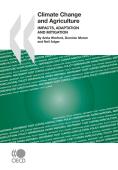
The OECD has developed a Policy Guidance with information and advice on how to facilitate the integration of adaptation within development processes. While efforts to integrate climate change adaptation will be led by developing country partners, international donors have a critical role to play in supporting such efforts as well as in integrating consideration of adaptation within their own plans and activities. To this end, partners and donors alike need operational guidance.
The objectives of the OECD Policy Guidance are to: i) promote understanding of the implications of climate change on development practice and the associated need to mainstream climate adaptation in development co-operation agencies and partners countries; ii) identify appropriate approaches for integrating climate adaptation into development policies at national, sectoral and project levels and in urban and rural contexts; and iii) identify practical ways for donors to support developing country partners in their efforts to reduce their vulnerability to climate variability and climate change.
This publication presents new measures and new ways of looking at traditional indicators. It builds on 50 years of indicator development by OECD and goes beyond R&D to describe the broader context in which innovation occurs. It includes some experimental indicators that provide insight into new areas of policy interest. It highlights measurement gaps and proposes directions for advancing the measurement agenda.
This publication begins by describing innovation today. It looks at what is driving innovation in firms, and how the scientific and research landscape is being reconfigured by convergence, interdisciplinarity and the new geography of innovation hot spots. It presents broader measures of innovation, for example using new indicators of investment in intangible assets and trademarks.
In the first post-transition decade after the fall of communism, Europe and Central Asia (ECA) moved its economy from plan to market. In the second decade, the 2000s, it moved from social division to inclusion. The region has an opportunity to use the third decade, the 2010s, to move from brown to green growth making production and consumption more sustainable, increasing quality of life, and reducing impacts on the climate. Lowering climate change risks in ECA will involve many different actions that fall broadly into three areas. Some, like energy efficiency improvements, are often economically beneficial regardless of climate concerns. Others, like creating a good business environment for green enterprises, are investments that create new growth opportunities. Finally, actions like expanding wind and solar energy will have net costs for some time but are essential to tackling climate change. A simple framework helps guide climate action. The priorities are to use energy more efficiently, use cleaner energy, and manage natural resources better.
In 2005, the concept of green growth was introduced in the Asia-Pacific region as a strategy for sustainable growth in developing countries. This roadmap, produced by the United Nations Economic and Social Commission for Asia and the Pacific (UNESCAP), is intended for the use of member states to help policymakers find win-win strategies for promoting growth and reducing carbon emissions. Drawing upon innovative approaches, particularly from the Republic of Korea, this manual lays out the challenges, strategies and policy options of green growth in several critical sectors.
The document is divided into two parts, with additional case studies and fact sheets available via CD-ROM. Part one presents an overview of the opportunities and challenges the region faces regarding low carbon green growth. It also discusses the system change required to shift focus to this new development path. Part two of the roadmap shows how to start the process of pursuing green growth through five different tracks, outlined below, which are seen as core elements of necessary systemic change:
